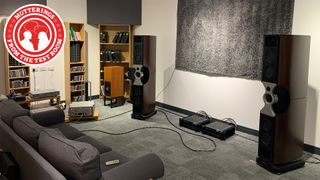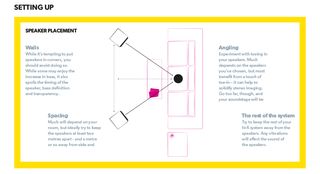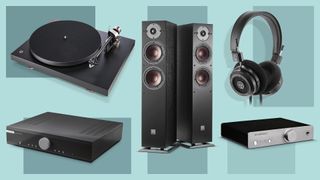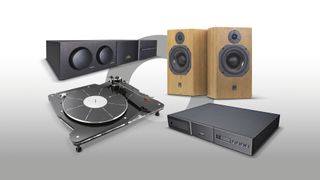"It's no good having an orchestra with the ten best guitarists if I don't have a pianist," said former Real Madrid manager Manuel Pellegrini, voicing his frustrations at the challenge of building a squad at the Bernabéu.
It’s an elegant metaphor, whether it’s describing a musical ensemble, a football team or a hi-fi system. In essence, building the perfect hi-fi system is as much about balance as it is about individual quality. The components need to be good, of course, but just as crucially they need to work well together. Indeed, in the best hi-fi systems, the whole will amount to more than (or at the very least equal) the sum of its parts.
But balance is one of those concepts that can be hard to define let alone achieve. While a lot of it boils down to trial and error, there are certain guidelines that will aid and, hopefully, ease your path to balance and consequent sonic enlightenment.
So let's get started. Here's how to go about assembling the right components and building the perfect hi-fi...
Set a budget, make a checklist

The first two questions you need to ask yourself are: what will you be using your system for, and how much are you willing to spend? The latter relates to the former, and each decision you make on components will have a knock-on effect.
It would perhaps be easiest to begin at the start of the chain – what will you be using as your source? If you play all your music from your smartphone or tablet but still want a traditional hi-fi system, you will want something (a standalone streamer or streaming amplifier) that supports Bluetooth and/or wi-fi – and if you're nodding your head at the latter, perhaps something compatible with AirPlay 2 or Google Cast too.
If you play mostly records, however, you will need to think about whether you want the necessary phono stage part of vinyl playback built into your turntable or your stereo amplifier, or if you plan to buy one separately instead – a standalone phono stage will ensure greater versatility when upgrading in the future, and often better sound.
And if you have taken on the task of ripping your entire music collection, maybe it's time to retire that CD player and invest in a well-featured music streamer instead?
It’s probably worth making a checklist of the features you want – such as a headphone output or Bluetooth if they're must-haves – and then prioritising the things you need most and those you can do without. That way, your money will go further.
Starting with a realistic budget will help you spread your money more evenly. After all, there's no point buying your dream amplifier only to match it with a budget turntable (the flaws of which it will emphasise) and a pair of speakers you found by your neighbour’s bin.
Generally, it doesn't typically make sense to overspend in one area. All parts of a system – source, amplification and speakers – are equally important and the balance between them should be broadly even. If anything, the weighting might lean more heavily towards your source and amplifier than your speakers.
There’s more to building the perfect hi-fi system than simply buying components that retail at a similar price, of course, but budgeting properly ought to set you on the right path.
Think about your room

You might also have space restrictions. If you don't have room for multiple components, you will need to consider if you can pool certain functions to reduce the number of boxes in your set-up. This could be buying a turntable with a built-in phono stage; or a multi-talented system with, say, an amplifier and CD player combined or a streamer and amplifier combined; or a pair of active speakers that integrates amplification into the speaker cabinets.
While separate components are ultimately the way to go for outright sound quality and upgradeability, this bundled route needn’t affect the quality of your system. This isn’t a decision that needs to be made solely on space either – perhaps you would simply prefer fewer boxes! – but think carefully about which parts you are most likely going to upgrade down the line. It will help to future-proof your system.
As our technical editor likes to remind people, a system's most important component is actually the room it's placed in. "Get this right and the system, whatever its calibre, has more chance of performing optimally," he says. "Get it wrong and even the very best high-end products will fail to shine.
"We all just want a balanced-sounding room that doesn’t emphasise any particular part of the frequency range, but instead strikes a natural balance between liveliness and being damped enough to avoid any unwanted reverb."
This is why it's the number one mistake in our crucial mistakes to avoid when setting up your hi-fi system article, so consider reading that if you're wondering what you can do to make your system work optimally in the space it sits in.
Choose the right speakers

Stereo speakers react differently depending not only on the size and characteristics of the room they are placed in but also their position in it, and on how close they are to each other and to any walls. Therefore, the best-sounding pair when listening at a dealership might not be the best-sounding pair when you get them home.
Don’t be blasé when it comes to positioning. We always recommend measuring the dimensions of your room when it comes to choosing the right speakers. Speakers are likely to come with a manual with the manufacturer’s suggestions for placement. That said, there’s nothing like experimenting with a keen ear, so go with your gut. To help, here are some of the best songs to test your speakers (not forgetting our ultimate music tracks to test your hi-fi system guide, if you ever need more test track inspiration!)
Our comprehensive how to choose the right speakers and get the best sound article covers everything from choosing to setting up your speakers, so should guide you on your journey step by step, rule by rule.
Consider all options

Of course, you may not be building the perfect hi-fi system from scratch. Perhaps you already have one or more elements?
We often make the point that you shouldn’t dismiss a product simply because it doesn't have a What Hi-Fi? five-star rating – four-star kit is good too, and may be even better for you and your system than five-star kit. This is a particularly pertinent point if you are looking to add to something you already own. Certain products may not be flawless all-rounders, but they could well have the blend of talents you’re looking for.
So often in life, it’s the little things that can have the biggest influence, and that’s the case with system building.
Budget for any extras

Set aside funds for quality audio cables, speaker cables, an AV or hi-fi rack and, if necessary if you're buying standmount speakers, speaker stands. Scrimp here and you simply won’t get your money’s worth out of your system. The golden rule, as always, is: never buy anything without having heard it first.
A good support lets your kit perform optimally. Turntables in particular are sensitive and respond well to a rigid, low-resonance platform, so steer clear of those wobbly floorboards or uneven bits of carpet.
Cabling is one of the most critical elements of a system and something you should spend around 10 per cent of your system total on, as a rough guide.
If you can use a dedicated mains outlet too, that would be ideal. And avoid placing mains cables and signal cables too close to each other, as performance can suffer.
The best systems you can buy in 2023
So there you have it: a few tips and tricks to building the perfect hi-fi system, with links to more in-depth articles if you require them. To help you on your way and provide a few sparks of inspiration, we have put together a number of systems over the years that we know work together. We have listened to them together in our dedicated What Hi-Fi? test rooms.
We have covered various bases here: using different sources and system components, setting various budgets, selecting the best products of their time, and reflecting changing listening habits – along with some helpful alternatives.
Have a look to see what tickles your fancy, and start brainstorming your dream hi-fi system. Alternatively, you can build your own system and do your own compatibility research – and what better place to start than with the What Hi-Fi? Best Buy buying guides, which list the best products you can buy in each category, all tried and tested by yours truly? As a handy shortcut, here are our best hi-fi speakers, best turntables best music streamers, best CD players and best stereo amplifiers lists.

Five-star streaming hi-fi system (mid-range)
A five-star network streamer, amplifier and standmount speakers, featuring Award-winning kit from Bowers & Wilkins and Cambridge Audio. This three-way combination shows just how impressive a mid-range streaming hi-fi system can be.
Great (British) system for vinyl and streaming (budget)
If you have around £1600/$2499 to spend, you will struggle to do better than this for your money, British representatives or not. Featuring two sources (a turntable and streamer) plus an integrated amplifier and pair of standmount speakers – all five-star components.
Superb five-star turntable system (mid-range)
You can be sure you're getting the best out of the mighty, Award-winning Pro-Ject Debut Pro, and indeed your record collection, with this phono stage, integrated amp, floorstanding speakers and headphones system. It’s pretty clear from the number of boxes on display that we have gone for a full-on separates set-up here. To get the very best performance out of hi-fi kit, you need to use products that specialise in their own particular field.
Simple, awesome just-add-speakers streaming system (mid-range)
This system, with the Cambridge Audio Evo 75 taking the place of both amplifier and streamer, will give you the performance of a great separates system in a package that is more modern and minimalist – just three boxes. And that suits us.
Premium system that spins and streams (high-end)
It’s really hard to create a stereo system that combines rhythmic drive with a convincing soundstage, great timing and impressive dynamics. This five-figure system, comprising a Vertere turntable, Naim streamer, Electrocompaniet amplifier and ProAc speakers, does all of that really well. (Pictured above.)
CDs and vinyl combine in this thrilling system (mid-range)
We know streaming services are all the rage, but there's nothing quite like sliding a record out of its sleeve or peeling a CD out of its case to get the juices flowing. So we've built you a good old-fashioned turntable and CD player set-up that will really make the most of your collections. It's a real thriller.
CDs and streaming make up a perfect digital hi-fi system (budget)
Whether you think it’s sophisticated in looks or not, this system is certainly a sophisticated listen. The Marantz CD player and amp pairing work well together – as you would expect – and the new Bluesound streamer adds a punch of rhythmic consistency to proceedings that is rather impressive for its price. What’s more, we are really happy to be able to recommend floorstanders at an appropriate price.
Enjoy music on the go with this portable audio system (mid-range)
For convenience's sake, you could just pair a smartphone with a pair of the best wireless earbuds, but there are compromises with that particular set-up, not least with the medium of Bluetooth. Add a couple of different components to the equation (keeping a phone as the foundation), however, and you can build something that's portable enough not to trip you up and also doesn't sacrifice anything in the way of performance.
System suggestions based on older kit:
- Here's an excellent hi-fi system combining vinyl and streaming (2020)
- Here's a superb-sounding hi-fi system with streaming skills (2020)
- Here's a brilliant turntable, tablet and wireless speaker system (2020)
- Get killer on-the-go sound quality with this portable phone package (2020)
- Enjoy CDs and streaming with this complete digital hi-fi system (2020)
- 3 of the best 21st century turntable systems (2019)
- 3 of the best hi-res audio systems (2018)
- Best premium music streaming system (2018)
- Best portable music system (2018)
- Best budget turntable system (2018)
- Best budget music streaming system (2018)
- Best music streaming system under £1000 (2017)
- Best portable music system under £1500 (2017)
- Best turntable system under £2000 (2017)
- Best premium music streaming system under £4000 (2017)
- Best portable music system under £500 (2016)
- Best CD hi-fi system under £1000 (2016)
- Best turntable hi-fi system under £1500 (2016)
- Best laptop hi-fi system for £2000 (2016)
- Best music streaming hi-fi system for £3300 (2016)
- Best music streaming hi-fi system for £8000 (2016)

